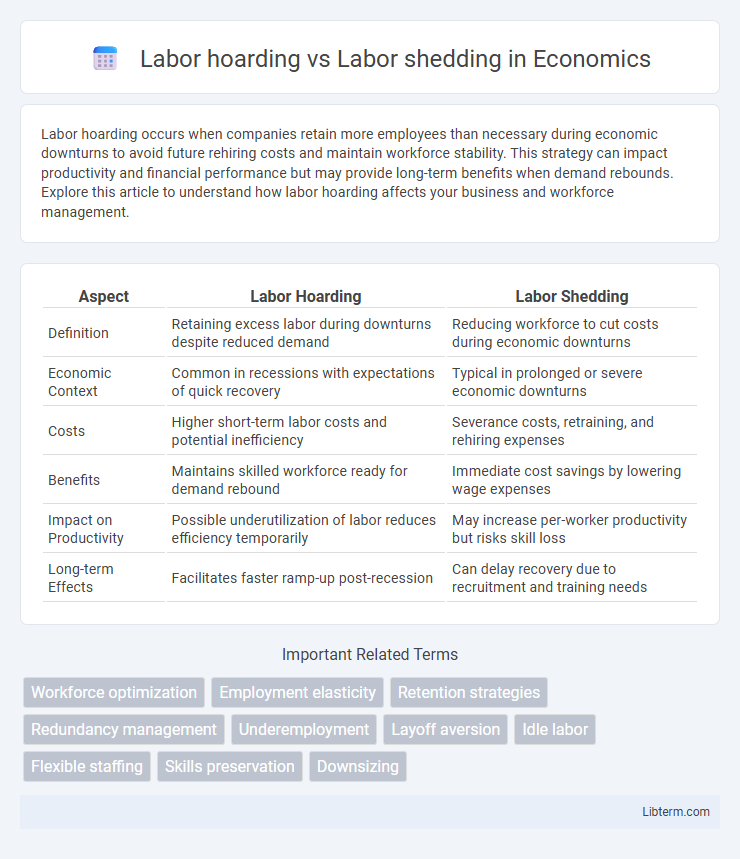Labor hoarding occurs when companies retain more employees than necessary during economic downturns to avoid future rehiring costs and maintain workforce stability. This strategy can impact productivity and financial performance but may provide long-term benefits when demand rebounds. Explore this article to understand how labor hoarding affects your business and workforce management.
Table of Comparison
| Aspect | Labor Hoarding | Labor Shedding |
|---|---|---|
| Definition | Retaining excess labor during downturns despite reduced demand | Reducing workforce to cut costs during economic downturns |
| Economic Context | Common in recessions with expectations of quick recovery | Typical in prolonged or severe economic downturns |
| Costs | Higher short-term labor costs and potential inefficiency | Severance costs, retraining, and rehiring expenses |
| Benefits | Maintains skilled workforce ready for demand rebound | Immediate cost savings by lowering wage expenses |
| Impact on Productivity | Possible underutilization of labor reduces efficiency temporarily | May increase per-worker productivity but risks skill loss |
| Long-term Effects | Facilitates faster ramp-up post-recession | Can delay recovery due to recruitment and training needs |
Understanding Labor Hoarding and Labor Shedding
Labor hoarding occurs when companies retain employees despite reduced demand to preserve skills, maintain morale, and avoid rehiring costs, often seen during economic downturns. Labor shedding involves reducing workforce size through layoffs or attrition to cut costs quickly in response to declining revenues or structural shifts. Understanding these strategies helps businesses balance short-term financial pressures with long-term operational capabilities and workforce stability.
Key Drivers Behind Labor Hoarding Strategies
Labor hoarding strategies are primarily driven by expectations of future demand stability, high replacement costs, and the desire to preserve firm-specific human capital. Firms opt for retaining employees during downturns to avoid the costs of rehiring and retraining when economic conditions improve. This approach contrasts with labor shedding, where immediate cost reduction takes precedence due to urgent financial pressures or permanent demand decline.
Factors Leading to Labor Shedding Decisions
Labor shedding decisions are primarily driven by factors such as declining demand, cost-cutting pressures, and technological advancements that reduce the need for human labor. Companies facing economic downturns often reduce their workforce to maintain financial stability and improve operational efficiency. Market uncertainty and shifts in industry trends also contribute to the strategic choice of labor shedding over labor hoarding.
Economic Impacts of Labor Hoarding
Labor hoarding occurs when firms retain more employees than necessary during economic downturns, which sustains consumer demand and stabilizes income distribution. This practice mitigates negative multiplier effects on the economy by preserving human capital and preventing skill erosion, facilitating quicker recovery once conditions improve. Unlike labor shedding, which reduces immediate costs but leads to higher unemployment and longer-term economic scarring, labor hoarding supports overall economic resilience and productivity.
Consequences of Labor Shedding on Workforce Stability
Labor shedding often leads to decreased workforce stability by increasing job insecurity and lowering employee morale. The reduction in staff can cause remaining employees to experience higher workloads, resulting in burnout and reduced productivity. Long-term consequences include loss of institutional knowledge and difficulties in rehiring skilled labor when economic conditions improve.
Labor Hoarding vs. Labor Shedding: Comparative Analysis
Labor hoarding involves retaining employees during economic downturns to preserve organizational knowledge and avoid rehiring costs, while labor shedding entails workforce reductions to immediately cut labor expenses. Comparative analysis shows labor hoarding can lead to higher long-term productivity and lower turnover, whereas labor shedding provides short-term financial relief but risks skill depletion and increased rehiring expenses post-recovery. Firms adopting labor hoarding strategies often experience smoother recoveries and sustained competitive advantage compared to those employing labor shedding.
Case Studies: Successful Labor Hoarding in Recessions
Case studies of successful labor hoarding during recessions highlight companies like Toyota and Southwest Airlines, which maintained their workforce to preserve skills and institutional knowledge. This strategy enabled faster recovery and innovation post-recession by avoiding rehiring and retraining costs. Research from the National Bureau of Economic Research indicates firms practicing labor hoarding achieve higher productivity and competitive advantage in subsequent economic upturns.
Risks and Challenges of Labor Shedding for Businesses
Labor shedding poses significant risks such as loss of institutional knowledge and reduced employee morale, which can impair long-term business performance. It often results in increased rehiring and training costs when economic conditions improve, leading to operational inefficiencies. Furthermore, abrupt workforce reductions may damage a company's reputation, complicating talent acquisition and retention efforts.
Balancing Productivity and Employee Retention
Labor hoarding involves retaining more employees than immediately necessary, preserving skilled labor to maintain productivity during downturns and fostering long-term employee retention. Labor shedding reduces workforce size to cut costs quickly, which may improve short-term financial performance but risks losing experienced workers and harming future productivity. Balancing these strategies requires assessing market conditions and business goals to optimize productivity while minimizing talent loss and associated rehiring expenses.
Future Trends in Workforce Management Practices
Labor hoarding involves retaining more employees than necessary during economic downturns to preserve skills and maintain productivity, while labor shedding focuses on reducing workforce size to cut costs. Future trends in workforce management emphasize hybrid strategies combining advanced AI-driven analytics and flexible work models to optimize talent allocation dynamically. Embracing these approaches supports resilience and agility in adapting to shifting market demands and workforce expectations.
Labor hoarding Infographic

 libterm.com
libterm.com